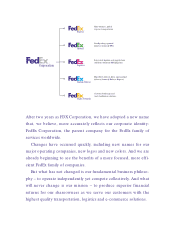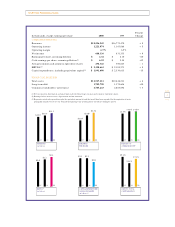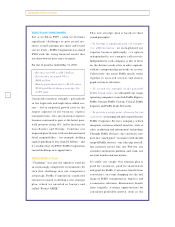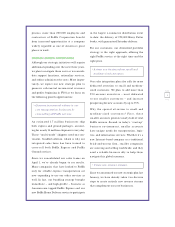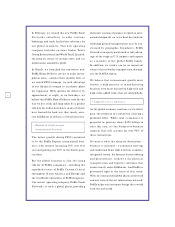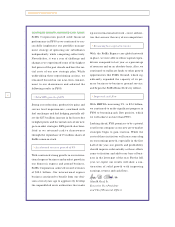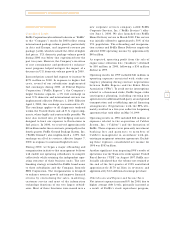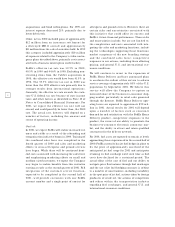Federal Express 2000 Annual Report Download - page 10
Download and view the complete annual report
Please find page 10 of the 2000 Federal Express annual report below. You can navigate through the pages in the report by either clicking on the pages listed below, or by using the keyword search tool below to find specific information within the annual report.
8
acquisitions and bond redem ptions. For 1999, net
interest expense decreased 21% primarily due to
lower debt levels.
Other, net in 2000 included gains of approxim ately
$12 million from an insurance settlem ent for
a destroyed MD11 aircraft and approximately
$11 m illion from the sale of securities held. In 1999
this category included approxim ately $10 m illion
of expenses related to the Com pany’s strike contin-
gency plans described above, primarily costs associ-
ated with a business interruption credit facility.
FedEx’s effective tax rate was 39.5% in 2000,
40.5% in 1999 and 44.6% in 1998. Excluding non-
recurring item s from the Caliber acquisition in
1998, the effective rate would have been 41.5% in
1998. The 39.5% effective tax rate in 2000 was
lower than the 1999 effective rate primarily due to
stronger results from international operations.
Generally, the effective tax rate exceeds the statu-
tory U.S. federal tax rate because of state income
taxes and other factors as identified in Note 10 of
N otes to Consolidated Financial Statem ents. For
2001, we expect the effective tax rate will not
exceed, and could possibly be lower than, the 2000
rate. The actual rate, however, will depend on a
num ber of factors, including the amount and
source of operating incom e.
O utlook
In 2001, we expect FedEx will realize increased vol-
um es and yields as a result of the rebranding and
reorganization initiative begun in 2000. Training of
the com bined sales force was com pleted in the
fourth quarter of 2000 and sales and marketing
efforts to cross-sell express and ground services
have begun. While there will be continued front-
end costs associated with increasing the sales force
and emphasizing marketing efforts on sm all and
m edium -sized customers, we expect the Company
m ay begin to realize benefits from this initiative
starting as early as the second quarter of 2001. Full
integration of the customer service function,
expected to be com pleted in the second half of
2001, will provide customers with one FedEx
account num ber and a single point of contact for
all express and ground services. However, there are
certain risks and uncertainties associated with
this initiative that could affect its success and
FedEx’s future financial perform ance. Those risks
and uncertainties include, but are not limited to,
the com plexities and costs associated with inte-
grating the sales and marketing functions, includ-
ing the technologies supporting those functions;
m arket acceptance of the new branding strategy
and the combined sales force; com petitive
responses to our actions, including those affecting
pricing, and general U.S. and international eco-
nom ic conditions.
We will continue to invest in the expansion of
FedEx Home Delivery and have announced plans
to accelerate the rollout of this service to achieve
service coverage of approximately 80% of the U.S.
population by Septem ber 2001. We believe this
service will allow the Company to capture an
increased share of the business-to-consum er ship-
ping market, particularly in retail sales generated
through the Internet. FedEx Hom e Delivery oper-
ating losses are expected to approximate $50 m il-
lion in 2001. Actual results for 2001 will depend
upon a num ber of factors such as consum er
dem and for and satisfaction with the FedEx Hom e
Delivery product, com petitive responses to the
product, the extent of our ability to penetrate the
business-to-consum er electronic comm erce mar-
ket, and the ability to attract and retain qualified
contractors for the delivery network.
For 2001, fuel costs are expected to rem ain at levels
approaching those experienced in the second half of
2000. FedEx currently has jet fuel hedges in place to
fix the price of approxim ately one-third of the
anticipated jet fuel usage for 2001 and anticipates
retaining its fuel surcharge until such tim e as fuel
costs have declined for a sustained period. The
actual effect of the cost of fuel and our ability to
m itigate price fluctuations through fuel surcharges
and the use of jet fuel hedging contracts is subject
to a num ber of uncertainties, including variability
in the spot price of jet fuel, actions taken by foreign
producers of crude oil, the actions of com petitors
and others within the transportation industry
regarding fuel surcharges, and general U.S. and
international econom ic conditions.


